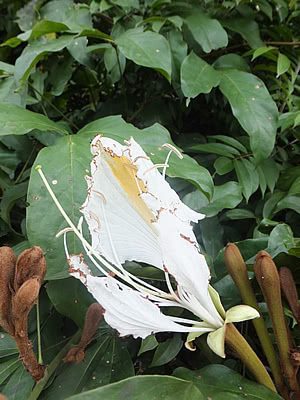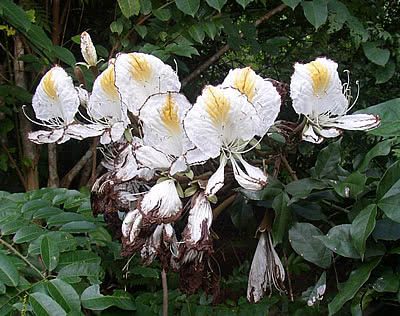Camoensia (Camoensia scandens)is a twining ornamental vine with large, fragrant flowers native to the Gulf of Guinea region in Africa, still rare in cultivation. Its exotic beauty and scented blossoms make it an exceptional choice for those looking to transform their garden into a tropical retreat. The genus name, “Camoensia“, pays homage to the Portuguese poet Luís de Camões, renowned for the nationalist epic ‘Os Lusíadas’. The species epithet, “scandens“, refers to the climbing behavior of the plant.
Camoensia is a vigorous and branched climber with dark, pinnate leaves composed of elliptical and pointed leaflets. It produces some of the largest flowers among Fabaceae (legumes). Its flowers appear in late summer and fall, white in color, with long stamens and petals fringed and outlined in brown. One of the petals is larger and dorsal with a yellow stripe at the center, while the others are long and tapered. The flower calyx is tubular and tomentose, brown in color.

Camoensia’s robustness makes it perfect for heavier structures such as pergolas and arbors. By adding this vine to your garden, you not only introduce an exotic touch but also create a shaded sanctuary during scorching summer days. Its dense foliage provides the perfect environment for moments of rest and relaxation. The flowers are a special attraction. Uncommon, large, and fragrant, they appear like the sketch of a masterpiece due to their outlined appearance. They are hardy and low-maintenance, yet it’s necessary to prune excessive branches that densely overlap the trellis to reduce weight on the structure, restore vigor to the plant, and enhance its aspect.
Camoensia doesn’t demand overly complex care, but a few points are crucial for its exuberant flowering. Cultivate it in full sun or partial shade, in deep soil rich in organic matter. Regular watering to keep the soil moist is important, especially in hot and humid climates that simulate its native tropical conditions. Due to its tropical nature, it’s not resistant to intense cold, frost, or prolonged drought. Therefore, ensure a warm and humid environment for its healthy growth.
Known for its resilience and low-maintenance nature, Camoensia still requires some attention to maintain its beauty. After flowering, it’s advisable to perform pruning for control and cleanliness. This not only revitalizes the plant but also reduces branch weight on the support structure, improving the overall appearance. Propagation can be done through cuttings and seeds. Although seed propagation is possible, many gardeners prefer cuttings for their reliability and ability to ensure the characteristics of the mother plant are passed onto the new seedlings.


